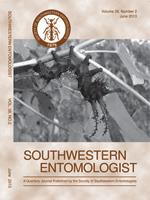A great diversity of trichogrammatids (35 genera) has been reported for Mexico. Particularly, several species of the genus Trichogramme are widely used as biological control agents in integrated agricultural pest management programs in Mexico. The identification of trichogrammatid wasps based on morphological characters is complicated. A feasible alternative to those taxonomic problems is the utilization of molecular techniques. Therefore, the objectives of the present study were to differentiate the most common genera of Trichogrammatidae, and infer their phylogeny, based on the molecular markers ITS2 and 18S of the rDNA and COII of the mDNA. Thus, individual wasps of Ittys, Aphelinoidea, Paracentrobia, Pseudoligosita, Ufens, Burksiella, Zagella, and Trichogramma were subjected to DNA extraction, DNA amplification by PCR, and phylogenetic analysis by the maximum parsimony (MP) method, based on the use of the molecular markers ITS2 and 18S of ribosomal DNA (rDNA) and COM of mitochondrial DNA (mDNA). PCR-product sizes of the region ITS2 varied from 450 to 700 bp for the more common genera of Trichogrammatidae from Mexico, which is useful for the taxonomic studies of these parasitic wasps. On the contrary, PCR-product sizes of the regions 18S and COII did not vary among genera, whose values were about 790 and 300 bp, respectively. PCR-product sizes of the regions ITS2 Y COII for most of trichogrammatid genera are reported for the first time. Phylogenies obtained based on the sequences of the ITS2 region were congruent with the current classification of Trichogrammatidae based on morphological characters.
Una gran diversidad de tricogramátidos (35 géneros) se han reportado para México. Particularmente varias especies del género Trichogramme se utilizan ampliamente como agentes de control biológico en los programas de manejo integrado de plagas agrícolas en México. La identificación de las avispas tricogramátidos mediante caracteres morfológicos es compleja. Una alternativa factible a la problemática anterior, es la utilización de técnicas moleculares. Por lo anterior el objetivo del presente estudio fue diferenciar los géneros de Trichogrammatidae más comunes de México, e inferir su filogenia basándose en los marcadores moleculares ITS2 y 18S del ADNr y COII del ADNm. Los tamaños de los fragmentos de PCR de la región ITS2 del ADNr variaron de 450 a 700pb en los géneros de Trichogrammatidae, lo cual es de gran utilidad en estudios taxonómicos de estas avispas parasíticas. Por el contrario, las regiones 18S del ADNr y COII del ADNm no mostraron variación en los tamaños de los fragmentas de PCR, siendo éstos de alrededor de 790 y 300pb, respectivamente, para los diferentes géneros. Se reporta por primera vez los tamaños de productos de PCR de las regiones ITS2 Y COII para la mayoría de los géneros analizados. Las filogenias inferidas mediante el mátodo de maxima parsimonia (MP), difirieron entre marcadores moleculares. Las filogenias inferidas mediante las secuencias de la región ITS2 fueron congruentes con la clasificación basada en caracteres morfológicos de géneros de Trichogrammatidae actualmente aceptada.





